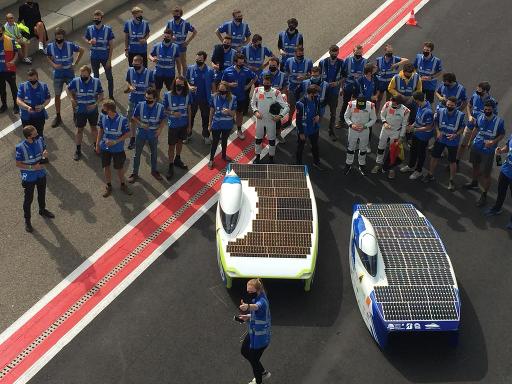In the wake of Belgium's triumphant win at the World Championships for Solar Cars, the question is whether solar roofs on our cars will soon become a reality.
Earlier this week, the Belgian team secured a world title at the Solar Challenge, the prestigious World Championship for solar cars held in Australia. As was the case in the 2019 edition, the Belgian team once again emerged as the fastest, owing their victory to a combination of clever strategy and cutting-edge solar cell technology integrated into their vehicle.
The solar car project was a collaborative effort between students from KU Leuven and a team from Imomec, a partnership between the renowned research centre Imec and UHasselt, and a part of EnergyVille, led by Hari Sivaramakrishnan.
Sivaramakrishnan highlighted the continuous improvement in solar cell technology, which played a pivotal role in the Belgian team's success.
While he couldn't reveal the exact efficiency gains achieved in 2023, he pointed out that commercial solar cell technology sees an annual improvement of about half a per cent. Over four years, this amounts to a substantial 2% increase, offering potential for the commercial automotive market.
When it comes to the question of whether solar cars will become an everyday reality, Sivaramakrishnan said it's not a matter of if, but when. In an interview with VRT NWS, he shared his insights on the future of solar-powered vehicles.
What are the benefits?
But what are the implications of this technology for conventional electric cars? The benefits are substantial. In regions with ample sunlight, integrating solar cells into electric vehicles can significantly extend their driving range. It can also power auxiliary systems, like air conditioning, reducing strain on the battery.
"If you live 30 km from work and leave the car in the sun during your working hours, that can generate enough energy to drive there and back," he told VRT. According to data from the Dutch start-up Lightyear, such technology can potentially add 60 to 70 kilometres of range in a day.

Solar Energy car of the Punch Powertrain Solar Team, which participated in the World Solar Challenge in Australia in August 2013. Credit: Belga / Seppe Knapen
However, it's important to note that vehicle design must be adapted to maximise the efficiency of solar cells. Sivaramakrishnan emphasised that vehicles need to be built with solar cells in mind, rather than retrofitted.
As for when we can expect to see solar-powered cars on the road, Sivaramakrishnan estimates it won't be for the first few years. He predicts it will likely take five to seven years before such vehicles become more common. This timeframe aligns with the ongoing transition to traditional electric cars, which are still in the process of becoming mainstream.
Challenges persist
The challenges associated with implementing this technology are underscored by the recent bankruptcy of Lightyear, demonstrating that it's not a straightforward endeavour. However, as the technology matures and electric vehicles gain more traction, manufacturers may begin to offer a "solar pack" as an optional feature alongside other vehicle customization options.
The evolution of this technology is expected to occur in phases. Initially, large panoramic glass roofs with integrated solar cells will be utilised, with promising test results already in progress. In a second phase, solar cells may be integrated into the bonnet and boot lid, and eventually, even the sides and windows of vehicles.
While solar-powered vehicles are not imminent, they are indeed on the horizon, and Belgium's recent success in the World Championships for solar cars has accelerated the journey toward a greener and more sustainable future for the automotive industry.

